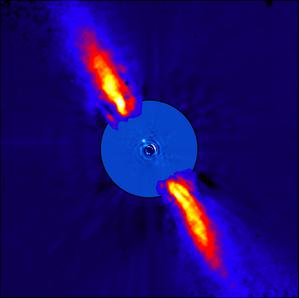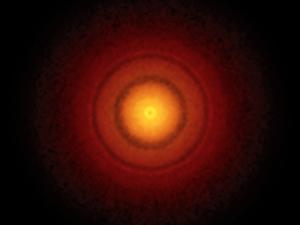Glossarbegriffe: Planetenentstehung
Description: Wenn eine Gaswolke im Weltraum zu einem Stern kollabiert, wird der entstehende Stern von einer wirbelnden Scheibe aus Gas und Staub umgeben. Dies ist eine protoplanetare Scheibe, in der sich Planeten bilden: Eisbedeckte Staubteilchen haften aneinander und bilden etwas größere Klumpen, die weiter wachsen. Es gibt noch offene Fragen darüber, wie die nächsten Stadien ablaufen: Welche Rolle spielt zum Beispiel die turbulente Gasbewegung, die diese Klumpen näher zusammenbringt? Schließlich bilden sich sogenannte Planetesimale, die mehr als einen Kilometer groß sind. Einige dieser Planetesimale ziehen sich aufgrund der Schwerkraft gegenseitig an und bilden größere Planeten. Ein Teil der Planetesimale bleibt als Asteroiden übrig. Einige Protoplaneten können große Mengen an Gas ansammeln und werden zu Gasriesen. Einige andere Protoplaneten in kalten Regionen, die weit vom Zentralstern entfernt sind, akkretieren große Mengen an gefrorenem Material und Gas und werden zu Eisriesen. Andere, mit weniger Gas, werden zu Gesteinsplaneten.
Zugehörige Glossarbegriffe:
See this term in other languages
Term and definition status: The original definition of this term in English have been approved by a research astronomer and a teacher The translation of this term and its definition is still awaiting approval
The OAE Multilingual Glossary is a project of the IAU Office of Astronomy for Education (OAE) in collaboration with the IAU Office of Astronomy Outreach (OAO). The terms and definitions were chosen, written and reviewed by a collective effort from the OAE, the OAE Centers and Nodes, the OAE National Astronomy Education Coordinators (NAECs) and other volunteers. You can find a full list of credits here. All glossary terms and their definitions are released under a Creative Commons CC BY-4.0 license and should be credited to "IAU OAE".
Zugehörige Medien
beta Pictoris b
Bildnachweis: ESO/A.-M. Lagrange et al. credit link
License: CC-BY-4.0 Creative Commons Namensnennung 4.0 International (CC BY 4.0) icons
Planet formation around the star TW Hydrae
Bildnachweis: S. Andrews (Harvard-Smithsonian CfA); B. Saxton (NRAO/AUI/NSF); ALMA (ESO/NAOJ/NRAO) credit link
License: CC-BY-4.0 Creative Commons Namensnennung 4.0 International (CC BY 4.0) icons
Related Activities
Creating Asteroids
astroEDU educational activity (links to astroEDU website) Description: Have fun, building asteroids using clay!License: CC-BY-4.0 Creative Commons Namensnennung 4.0 International (CC BY 4.0) icons
Tags: Hands-on , Model Age Ranges: 4-6 , 6-8 , 8-10 Education Level: Pre-school , Primary Areas of Learning: Modelling , Social Research Costs: Medium Cost Duration: 1 hour 30 mins Group Size: Group Skills: Communicating information , Developing and using models










